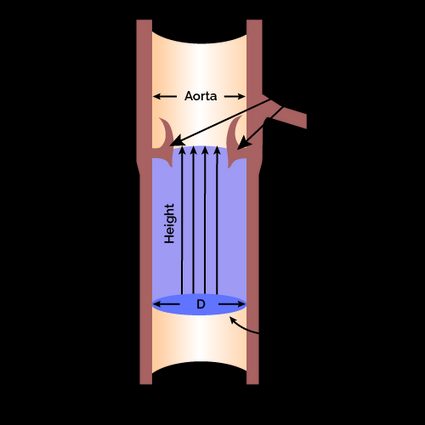Doppler Echo Cardiac Output Calculator
Welcome to the Doppler echo cardiac output calculator for professionals. The guide below will lead you through the functionalities of a tool and remind you of a few crucial definitions connected to the subject.
Keep on reading to expand your knowledge on:
- Non-invasive cardiac output estimations;
- The Doppler cardiac index calculations; and
- Defining properties of LVOT, cardiac output, stroke volume, and cross-sectional area (LVOT CSA).
Disclaimer: We try our best to make our Omni Calculators as precise and reliable as possible. However, this tool can never replace professional medical advice.
Left ventricle hemodynamics measured with echo Doppler
Echocardiography Doppler is a non-invasive method of heart imagining. Echo uses a typical ultrasound machine connected to a probe of a different shape. While the heart structures can be easily visible in us, a physician needs to use the Doppler effect if they want to visualize the blood flow and measure its velocity.
Echo Doppler function allows us to measure:
-
LVOT diameter (left ventricular outflow tract diameter) – LVOT is the region of a left ventricle that further turns into the aorta; and
-
LVOT VTI (left ventricular outflow tract velocity time integral) – velocity measured during the ejection phase, aka the stroke distance.
These values are needed for the stroke volume calculations, the cross-sectional area of LVOT, cardiac output, and cardiac index of a left ventricle. You may calculate them by hand or make your life easier by trying the Doppler echo cardiac output calculator on your left.
How to calculate stroke volume with echocardiography Doppler?
Let's compute it step by step.
-
Measure the LVOT diameter and LVOT VTI using Doppler echocardiography.
-
Find the cross-sectional area (CSA) with:
CSA = π × (LVOT diameter/2)² -
Calculate stroke volume using:
Stroke volume (mL) = CSA × LVOT VTI
Units:
LVOT diameteris given in cm;CSAis given in cm²; andLVOT VTIis given in cm.
💡 Why do we use the equation for the circle area?
It's easier to understand if you imagine LVOT as a cylinder (see diagram below); its base is equal to the area of CSA, while its height is approximate to LVOT VTI (which describes the stroke distance measured with the echo-Doppler).

How to calculate cardiac output with echocardiography Doppler?
Follow the simple guide:
-
Measure the LVOT diameter and LVOT VTI using Doppler echo.
-
Using the following formula, find the cross-sectional area (CSA):
CSA = π × (LVOT diameter/2)² -
Find the stroke volume using:
Stroke volume = CSA × LVOT VTI -
And finally, compute the cardiac output.
Cardiac output (L/min) = Stroke volume × Heart rate /1000
Units:
LVOT diameteris given in cm;CSAis given in cm²;LVOT VTIis given in cm; andStroke volumeis given in mL.
How to use the Doppler echo cardiac output calculator?
Our hemodynamics echo calculator requires exactly 5 tasks to complete:
- Enter your patient's height.
- Choose your patient's weight.
The tool needs both these values to execute the Mosteller's equation for body surface area - taken from the BSA calculator. - Input the heart rate.
In beats per minute. - Measure LVOT VTI.
Left ventricular outflow tract velocity time integral. - Enter the LVOT diameter.
That's all you need – your CO and CI results will be automatically displayed.
💡 Click on the Advanced mode button at the bottom of the Doppler echo cardiac output calculator to show computed values of:
- Stroke volume;
- Cross-sectional area of LVOT (CSA); and
- Calculated body surface area.
Normal values of Doppler echo cardiac output calculator
Have you been wondering what the physiological values for the variables used in our calculator are? Look no further!
- Heart rate: 60-100 bpm
- LVOT VTI: >18 cm
- LVOT diameter: 18-22 mm
- Cardiac output: 4-8 L/min
- Cardiac index: 2.5-4.0 L/min/m²
- Stroke volume: 50-100 mL
- Cross-sectional area of LVOT: 2.5-3.8 cm²
FAQs
What is cardiac output?
Cardiac output (CO) describes the amount of blood pumped by the heart during exactly one minute. We compute it by multiplying the amount of blood pumped during one contraction by the number of heart contractions (heart beats):
CO = Stroke volume (ml) × Heart rate (beats per minute)
What is LVOT?
LVOT stands for the left ventricular outflow tract. LVOT represents the cylindrical region of the left ventricle that leads to the aorta. Its volume is determined by the anterior cusps of the mitral valve and ventricular septum.
-
LVOT can be visualized with the use of echocardiography Doppler.
-
We may use LVOT to compute Doppler cardiac output, stroke volume, and Doppler cardiac index.
What's the difference between CO and CI?
Cardiac index (CI) is equal to cardiac output (CO) divided by the body surface area:
Cardiac index = Cardiac output / Body Surface Area
Cardiac output/ cardiac index can be computed using non-invasive echocardiography Doppler methods.